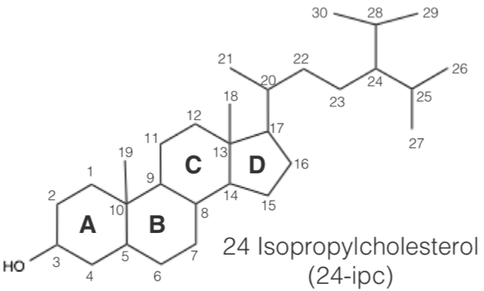2014 Annual Science Report
 Massachusetts Institute of Technology
Reporting | SEP 2013 – DEC 2014
Massachusetts Institute of Technology
Reporting | SEP 2013 – DEC 2014
Early Animals: Lipid Biomarkers as the Earliest Evidence of Metazoans
Project Summary
A complex hydrocarbon, 24-isopropylcholestane, has been proposed as a biomarker for a particular group of sponges—the earliest-branching animals—and found in Neoproterozoic rocks. However, a particular group of marine algae, the pelagophytes, can also produce the precursor to this compound, and it has not been known whether this ability is more widespread within the eukaryotes. We have used genomic data combined with time-calibrated phylogenies to approach this question and find that pelagophytes did not evolve this ability until the Paleozoic, while in sponges it evolved in the Neoproterozoic. This work supports the conclusion that this sterane is a true sponge biomarker.
Project Progress
24-isopropylcholestane is a sterane found in abundance in certain Neoproterozoic rocks ~640 million years old. It represents the diagenetic product of the 30-carbon (C30) sterol 24-isopropylcholesterol (24-IPC), which is produced in abundance by some modern sea demosponges. Thus, we have interpreted this sterane from ancient sediments as a sponge biomarker, and the oldest evidence for animals in the geological record. However, several recent papers have challenged this interpretation, arguing that (1) pelagophyte algae also produce trace amounts of 24-IPC, and could therefore be responsible for the sterane, and (2) there is a general lack of information about the distribution of C30 sterols within the eukaryotes, so labelling this sterane a sponge biomarker is premature.
We have previously argued that pelagophyte algae cannot be responsible for 24-isopropylcholestane based on the algae’s sterol biosynthesis pathway, but we are re-assessing the problem using a combined organic chemistry and comparative genomics approach. As part of our ongoing research, we have analysed the sterol repertoire from representatives of every major clade of organisms separating the fungi from the animals. We have discovered that these species only produce sterols ranging from C27 – C29, suggesting that within the Opithsokonts (the animals, fungi, and their close relatives), 24-IPC synthesis is unique to the demosponges. By correlating the sterol and genome repertoires of each species, we hypothesize that the production of C30 sterols has occurred through the duplication and evolution of the gene 24-methyltransferase. The history of this gene can be traced across the eukaryote tree, and an independent series of duplication events can be recovered in the lineage leading to pelagophyte algae. Preliminary results suggest that when these gene duplication events are mapped on to a time-calibrated molecular phylogeny, we find that sea sponge C30 synthesis evolved in the Neoproterozoic, while pelagophyte C30 synthesis did not develop until the middle Paleozoic. Ultimately, our research refutes the hypothesis that pelagophyte algae represent a candidate source of Neoproterozoic 24-isopropylcholestane, and supports the conclusions that this sterane represents a true sponge biomarker.
-
PROJECT INVESTIGATORS:
-
PROJECT MEMBERS:
Roger Summons
Project Investigator
David Gold
Co-Investigator
-
RELATED OBJECTIVES:
Objective 4.1
Earth's early biosphere.
Objective 4.2
Production of complex life.
